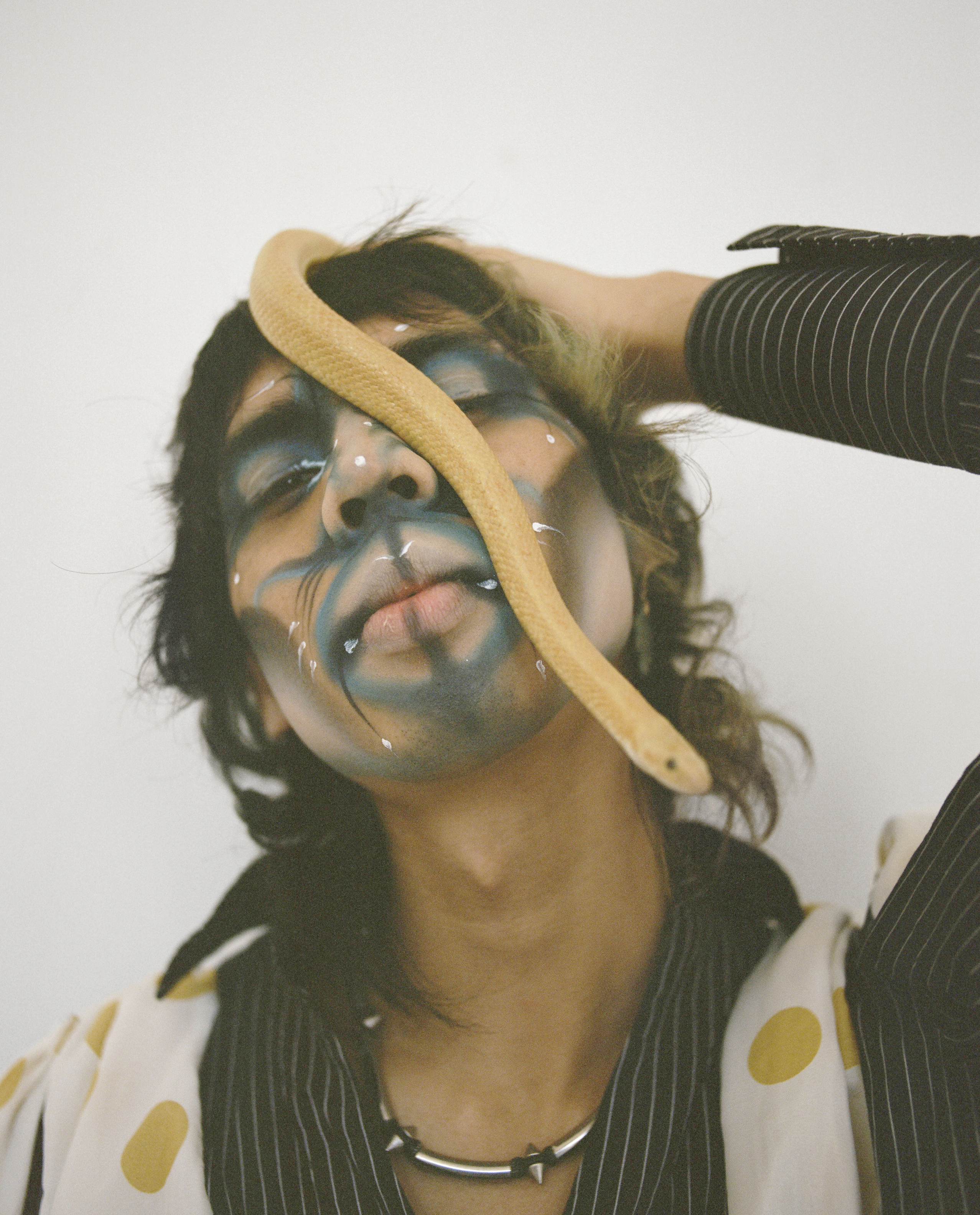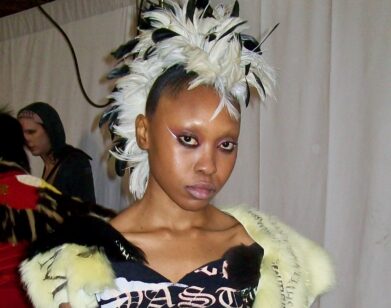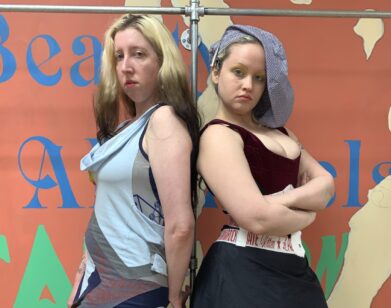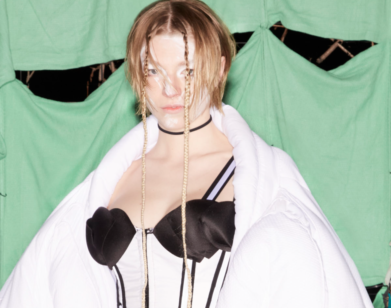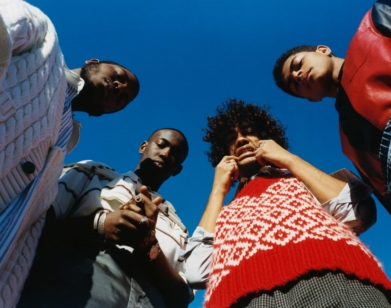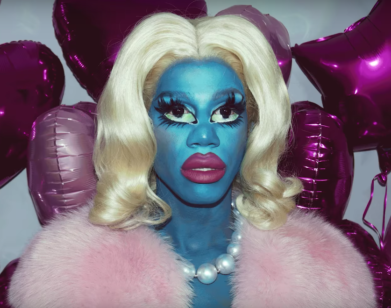Designer Gogo Graham uses makeup to distort and art to empower
Gogo Graham’s work is not easy to ignore. She’s known by most for her trailblazing fashion designs tailored to trans women, but she also explores her dazzling visions through makeup and music. Whether it’s the polka-dotted, corset-strapped, peekaboo constructions of her AW18 line, the video game-inspired soundscapes populating her Soundcloud, or the otherworldly makeup looks racking up likes on her Instagram, Graham consistently throws a wrench in the face of convention. Regardless of medium, her creative output demands attention. It is clear from speaking with her that this is not just an aesthetic; it’s a strategy for engaging critically with the world.
Graham is outspoken about her commitment to disruption. She calls for “representation of trans women by trans women,” and widespread dispersal of capital to marginalized folks—put your money where your politics are. These concerns are mirrored in her choice of collaborators, a core group of femme friends and creatives, including activist Cecilia Gentili, model Aurel Haize Odogbo, and artist Ser Serpas. Graham has also started partnering more frequently with avant-garde fashion collective Women’s History Museum, a group similarly absorbed with self-aware, critical creative production. Graham’s art keeps her busy, but she was kind enough to pull out her palette, create some striking looks, and talk with us about her craft. She is an artist we should all be listening to.
NGOZI NWADIOGBU: What is your biggest influence when it comes to creating new looks?
GOGO GRAHAM: Fems in my biological and chosen families inspire me most. Connecting with them is where it starts and the rest is just building whatever I can with the objects and materials I come across. I have skills related to organizing those things with balance and proportion and reproducing familiar shapes and imagery, but am not really inspired by objects in particular.
The important thing for me is to use the attention I have or am able to get to be able to keep doing what I’m doing and to economically empower the fems I work with. Having fashion shows gives me an opportunity to pay models. When I make art with superficially appealing textures and imagery, do makeup, make t-shirts that people like, I get opportunities with spaces and have the financial ability to have these shows. I’m not a business-minded person, and using my creative skills to create something visually or aurally appealing is the only thing I really know how to do to make space for that kind of small-scale redistribution of capital.
NWADIOGBU: You’ve talked in interviews before about playing games like Final Fantasy and Devil May Cry as a kid; do you see yourself experimenting with video game aesthetics in your makeup or fashion work?
GRAHAM: Yes, they’re on the top of my list of inspirations! The ways that faces, looks, expressions, articulations of bodies and garments within the context of an action/adventure RPG are endless is so exciting to me. I think I latched onto those things as a kid because they always included everything I found visually and aurally stimulating; high drama music, high drama clothing and makeup (even when characters aren’t dramatic themselves), a million different articulations of gender performance and expression, freaky armor, magic and old-timey looking weapons—the list goes on.
NWADIOGBU: Do you make all the soundtracks for your shows? How does making music fit into your creative work as a designer and makeup artist?
GRAHAM: For the past three or so art shows, and for the last fashion show, I made the soundtracks. Something that I really like doing is creating a scene or an atmosphere to go along with anything I present. I think sound is a really important part of feeling immersed in an environment, and that’s something I always want to do for people if it makes sense in the space.
NWADIOGBU: Do you use your study of evolutionary biology and pre-med at all in your creative work?
GRAHAM: I think everything is connected: math, chemistry, and other sciences are always present and inform everything we do in some way or another, whether we see it or not.
NWADIOGBU: Are there different experiences or aspects of your identity that you feel you can express better in fashion versus makeup, and vice versa? Is there a particular medium you prefer when dealing with certain subjects?
GRAHAM: I’m pretty practical when it comes to what kinds of work I make for each individual project. If I’m asked to have an art show or a fashion show and have a space available and there’s a budget, I take it and run with it; sculpture, painting, clothing, music, whatever I’m able to do with whatever resources are available. I have a lot of makeup at home and can basically do that any time I have a moment of free time and play with that frequently. When a makeup gig comes along, I approach it the same way of working with what’s available. I’m open to different media and I like to adapt to whatever situation presents itself to me.
NWADIOGBU: A lot of your pieces are personalized for the model wearing them and thus one-of-a-kind. Would you ever want to produce on a wider scale?
GRAHAM: If it were financially possible for me to do so, I probably would! That’s really the only thing holding me back. Fashion production requires a lot of money to function, and I’m not there yet!
NWADIOGBU: What’s it been like collaborating with Women’s History Museum?
GRAHAM: I am close friends with the women who run WHM, so we’re usually on the same page with our practices, and that’s really rare and cool to experience and be a part of. Amanda and Rivkah are incredibly creative and talented women, and the work we do together is really personal and magical to me. I love them!
NWADIOGBU: Your show Dragon Lady explored the exoticizing stereotype through the lens of what you described as “normative and horrific femme archetypes that exist within Japanese folklore.” A lot of your makeup looks, also, are more experimental and seem to toy with this idea of the grotesque made beautiful, featuring drawn on eyes and unique contouring and coloring. Is there a statement behind these kinds of makeup looks, are they just a lot more fun, is it both?
GRAHAM: I think it’s both. It’s fun to take personal, inherited cultural images, objects, and experiences and present them in ways that are maybe different than one might expect, but it’s also deeply fulfilling to participate in that culture using these artifacts as tools. Feminine objectification, feminine scapegoating, feminine hysteria, Orientalism, and exoticism are all also deeply ingrained into these cultural artifacts and the way they have circulated through American culture, and all inform my use of these tools.
NWADIOGBU: What do you think of the fashion industry making more of an effort to recognize and put money behind the creative work of those within the trans community? Is it just performative?
GRAHAM: I think under our current economic system, everything related to identity politics that doesn’t directly involve fostering redistribution of capital to oppressed communities is performative. A company functioning within this system is required to maximize profits in order to survive, and that is what will always be the priority. It is important to me to figure out how I can support the economic empowerment of others while also trying to realistically understand how I can survive and function within this structure myself.
NWADIOGBU: What’s next for you?
GRAHAM: I’m working on some sculptures and paintings right now. I’ll probably be raising funds over the next few months to get another show together, maybe by the end of this year. We’ll see!
KEEP UP WITH GOGO GRAHAM ON INSTAGRAM AND ON HER WEBSITE.

